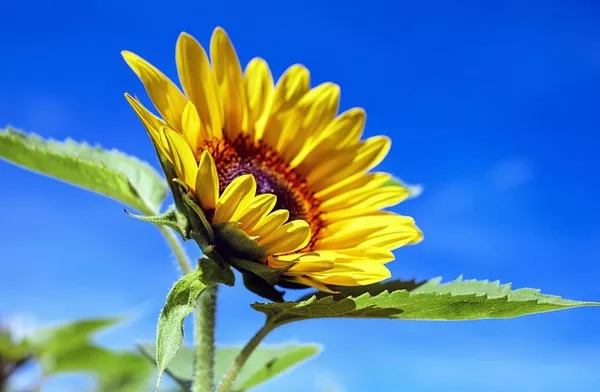Sunflowers (Helianthus annuus) are not only nature’s dazzling display of golden beauty but also a rewarding addition to any garden or landscape. Whether you’re a seasoned gardener or a novice enthusiast, growing sunflower seeds can be a gratifying and straightforward endeavor. This comprehensive guide will provide you with step-by-step instructions to ensure your sunflower seeds flourish into vibrant, towering plants.
Selecting Sunflower Varieties
Before embarking on your sunflower growing journey, it’s essential to choose the right sunflower variety for your space and purpose. There are different types of sunflowers, each varying in size, color, and purpose.
Giant Sunflowers: These varieties can reach heights of up to 15 feet or more, making them ideal for creating a stunning focal point in your garden.
Dwarf Sunflowers: These are more compact and suitable for smaller spaces, such as containers or borders.
Multipurpose Sunflowers: Some sunflowers are cultivated for their seeds, oil, or even ornamental purposes. Choose the variety that aligns with your goals.
Selecting the Ideal Location
Sunflowers thrive in full sunlight, so selecting the right location is crucial for their success. Look for an area that receives at least 6 to 8 hours of direct sunlight daily. Ensure that the chosen spot has well-draining soil to prevent waterlogging, as sunflowers are susceptible to root rot in overly moist conditions.
Preparing the Soil
Prepare the soil before planting to create an optimal environment for sunflowers to grow. Sunflowers are relatively adaptable, but they prefer moderately fertile, slightly acidic to neutral soil with a pH between 6.0 and 7.5. Incorporate organic matter, such as compost or well-rotted manure, to improve soil structure and fertility.
Sowing Sunflower Seeds
Sow sunflower seeds directly into the ground after the last frost has passed and the soil has warmed up, typically in late spring. Follow these steps for successful sowing:
Spacing: Depending on the variety, leave adequate space between each seed. Giant sunflowers might require 2 to 3 feet of spacing, while dwarf varieties can be spaced closer together.
Depth: Plant sunflower seeds about 1 to 2 inches deep. As a general rule, plant larger seeds deeper than smaller ones.
Watering: After sowing the seeds, water the area gently to settle the soil and ensure proper contact between the seeds and the soil.
Mulching: Apply a layer of organic mulch, such as straw or wood chips, to retain moisture, suppress weeds, and regulate soil temperature.
Caring for Growing Sunflowers
Once your sunflowers have sprouted, it’s important to provide them with appropriate care to encourage healthy growth and development.
Watering: While sunflowers are relatively drought-tolerant once established, consistent watering is essential during their initial growth phase. Water deeply and regularly to keep the soil consistently moist but not waterlogged.
Fertilization: Sunflowers benefit from balanced fertilizer application during their growing season. Apply a slow-release, all-purpose fertilizer according to the manufacturer’s instructions.
Support: Tall varieties, especially the giant ones, might require support as they grow to prevent them from toppling over in strong winds. Staking can be done using bamboo poles or other suitable materials.
Weeding: Regularly remove weeds from the sunflower bed to minimize competition for nutrients and water.
Pest and Disease Management: Keep an eye out for common pests like aphids, caterpillars, and birds that might feed on the young plants or seeds. Utilize appropriate insecticides or physical barriers to protect your sunflowers.
Harvesting Sunflower Seeds
Harvesting sunflower seeds is a rewarding process that requires patience and attention to detail. Here’s how to do it:
Seed Development: Sunflower heads will start to droop and their petals will dry and fall off as the seeds mature. The back of the head will turn from green to yellow.
Harvest Timing: Harvest the seeds when the back of the sunflower head turns brown and the seeds are plump and fully developed. This is typically around 30 to 45 days after flowering.
Harvesting Process: Cut the sunflower head from the stem, leaving a few inches of stem attached. Hang the heads upside down in a dry, well-ventilated area to complete the drying process.
Seed Removal: Once the sunflower heads are completely dry, rub the seeds off the head using your fingers or a fork. Collect the seeds in a bowl.
Storage: Store the harvested seeds in a cool, dry place in airtight containers. Sunflower seeds can be enjoyed as a nutritious snack or saved for future planting.
Conclusion
Growing sunflower seeds is an immensely rewarding experience that offers a sense of accomplishment and a stunning display of nature’s beauty. By selecting the right variety, providing proper care, and following these step-by-step guidelines, you can successfully cultivate sunflowers that will brighten your garden and bring joy to your outdoor space. Remember that gardening is also about patience and learning, so observe and adapt your practices to the unique conditions of your environment. With dedication and attention, you’ll soon be reaping the benefits of your sunflower-growing endeavor.


